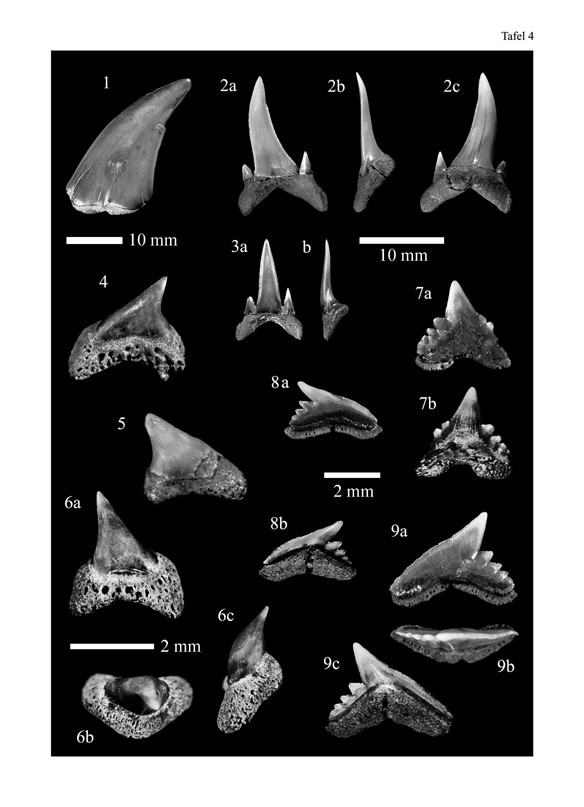
|

|
PALAEONTOS 14Price: non-members: 40 euros, members: 35 euros 1) Reinecke T., von der Hocht F. & Gürs K., 2008, Die Elasmobranchier des Vierlandiums, Unteres Miozän, im Nordwestdeutschen Becken aus Bohrungen und glaziofluviatilen Geröllen („Holsteiner Gestein”) der Vierlande-Feinsande (Holstein) und der Kakert-Schichten (Niederrhein). ISSN: 1377-4654.(54 textpages, 7 textfigures, 4 tables, 8 plates)Summary: This paper describes the elasmobranch fauna of the Vierlandian, Early Miocene (corresponding to the Aquitanian and Early Burdigalian), which is derived from glaciofluviatile sandstone boulders and flush-drillings through the Vierlande-Feinsand (resp. Unterer Glimmerfeinsand) in the eastern part of Schleswig-Holstein, and from flush and core-drillings through the Kakert beds of the Lower Rhine Basin, Germany. It comprises about 17 selachian and 6 batoid taxa, of which 12 and 5 resp. could be identified to species level. One batoid species, Raja holsatica sp. nov., ranging from the Eochattian to the Reinbekian, is new. Teeth of three species of skates and sting rays (Raja, Dasyatis) and of the shark genera Squalus, Carcharias, Premontreia (Oxyscyllium), Pachyscyllium and Physogaleus are particularly abundant. These already inhabited the shelf regions of the southern North Sea basin during the Chattian. The epipelagic-oceanic to near-shore sharks Alopias (thresher shark), Isurus (mako), Parotodus, Carcharoides and the batoid Mobula (devil ray) that were present during the Eochattian and partly the Neochattian and reappeared during the Hemmoorian, are absent or very rare (Isurus) in the Vierlandian. The lack of oceanic elements may be attributed to the absence of a stable, bathymetrically sufficiently deep sea-way linking the southern North Sea basin to the warm-temperate northeastern Atlantic. A few very warm episodes during the Vierlandian, not reflected by the elasmobranch fauna probably because of insufficient resolution, are indicated by benthic and planktonic gastropods of tropical/subtropical provenance. They may have entered the basin driven by oceanic currents even across a shallow barrier between the Atlantic and the southern North Sea. Not until early Hemmoorian (late Burdigalian, early Miocene) a marked sea level rise and climatic warming (leading to the mid-Miocene temperature optimum) led several new elasmobranchs of epipelagic-oceanic and/or subtropical/tropical character to enter the basin and replace some long-lasting taxa (e.g. Pachyscyllium braaschi, Dasyatis delfortriei). 2) Haye T., Reinecke T., Gürs K. & Piehl A., 2008, Die Elasmobranchier des Neochattiums (Oberoligozän) von Johannistal, Ostholstein, und Ergänzungen zu deren Vorkommen in der Ratzeburg-Formation (Neochattium) des südöstlichen Nordseebeckens.(51 textpages, 10 textfigures, 3 tables, 13 plates)Summary: A Neochattian Elasmobranch fauna collected from fossiliferous, dark-brown silts forming part of the Chattian Silt („Chatt-Schluffe”) of late Oligocene age is described from northern Germany. The silts were exposed on the surf platform of the Baltic Sea at Johannistal, near Heiligenhafen, Ostholstein. They belong to a tectonically disturbed sequence of Eocene, Oligocene and early Miocene clays und glauconite sands, which have been sheared off the Tertiary substratum and intercalated or mixed with glacial deposits during the Weichselian in the Wandelwitz-Johannistal push moraine. The Chattian Silt represents the basin facies of the late Oligocene in the southeastern North Sea. Its upper section is stratigraphically equivalent to the shallow-marine sands of the Ratzeburg-Formation in southeast Holstein and northeast Lower Saxony which have been deposited at the front of river deltas draining into the mid-German bight. The fauna of the Chattian Silt at Johannistal includes 18 shark and 6 batoid taxa, of which 13 and 5 resp. could be identified at species level. The fauna of the Ratzeburg-Formation (212 teeth recovered from about 40 glaciofluviatile sandstone pebbles collected at Groß Pampau, Kreis Herzogtum Lauenburg) comprises 12 shark and 4 batoid taxa which represent a part of the Chattian Silt fauna. The faunas of the Neochattian mediate between similar elasmobranch faunas of the Eochattian (Sülstorf Beds, Kassel Formation und Doberg Formation) and the Vierlandian, early Miocene („Vierlande- Feinsande” with „Holsteiner Gestein”; Reinecke, von der Hocht & Gürs, 2008; this volume). Dasyatis rugosa (Probst, 1877), Physogaleus singularis (Probst, 1878) and Cosmopolitodus aff. hastalis (Agassiz, 1838) had first occurred in the North Sea during the Neochattian. Carcharias sternbergensis Reinecke et al., 2005 und Raja sp. 1 existed for the last time in the Neochattian and have definitely been absent since the late Vierlandian (Vierlande-Feinsande). |
|
ORDER INFORMATION:please contact us at: palaeontos@gmail.com |
|